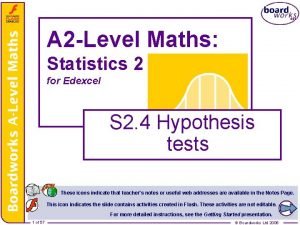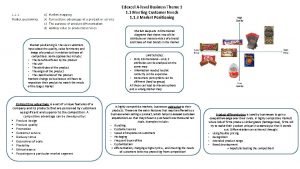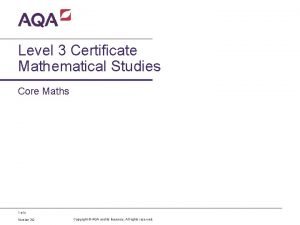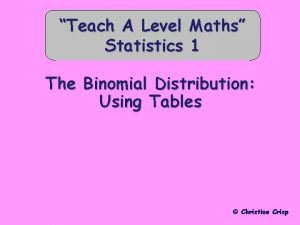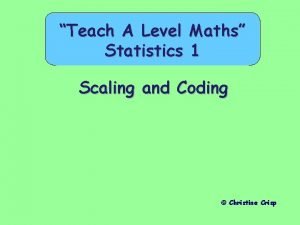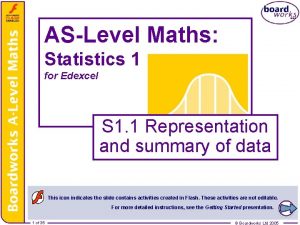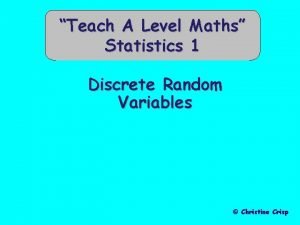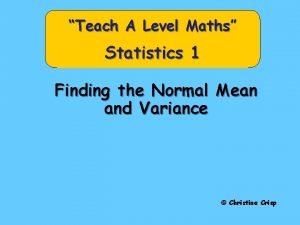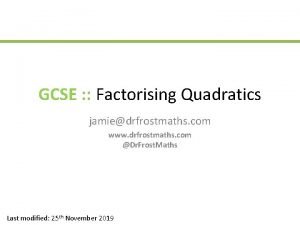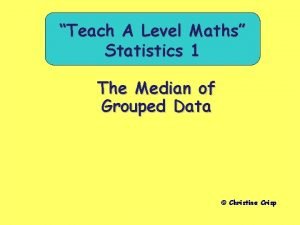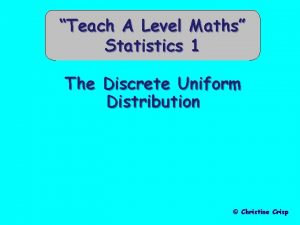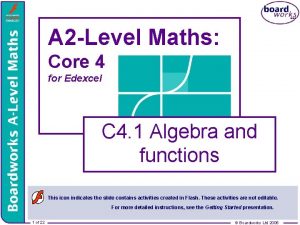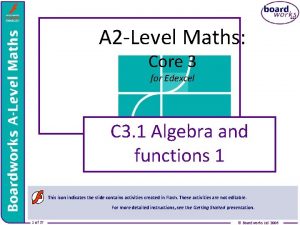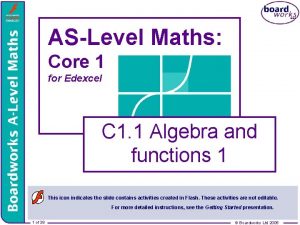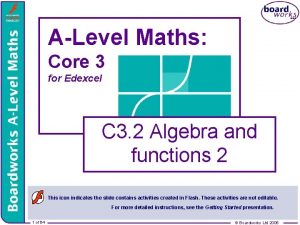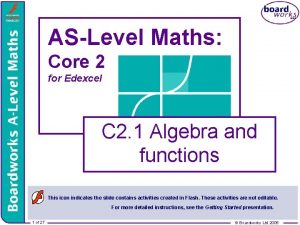A 2 Level Maths Core 4 for Edexcel


























- Slides: 26

A 2 -Level Maths: Core 4 for Edexcel C 4. 3 Sequences and series These icons indicate that teacher’s notes or useful web addresses are available in the Notes Page. This icon indicates the slide contains activities created in Flash. These activities are not editable. For more detailed instructions, see the Getting Started presentation. 1 of 26 © Boardworks Ltd 2006

Negative and fractional indices Contents Binomial expansion for negative and fractional indices Approximations Use of partial fractions Examination-style question 2 of 26 © Boardworks Ltd 2006

Binomial expansion Previously in the course we found that, when n is a positive whole number, This is a finite series with n + 1 terms. If n is negative or fractional then, provided that |x| < 1, the infinite series will converge towards (1 + x)n. 3 of 26 © Boardworks Ltd 2006

Binomial expansion In general, for negative and fractional n and |x| < 1, Expand up to the term in x 4. Start by writing this as (1 + x)– 1. The expansion is then: This is equal to (1 + x)– 1 provided that |x| < 1. 4 of 26 © Boardworks Ltd 2006

Binomial expansion Expand up to the term in x 3. Start by writing this as This converges towards That is when |x| < 5 of 26 . Here x is replaced by 2 x. provided that |2 x| < 1. . © Boardworks Ltd 2006

Binomial expansion When the first term in the bracket is not 1, we have to factorize it first. For example: Find the first four terms in the expansion of (3 – x)– 2. 6 of 26 © Boardworks Ltd 2006

Binomial expansion Therefore This expansion is valid for < 1. That is, when |x| < 3. In general, if we are asked to expand an expression of the form (a + bx)n where n is negative or fractional we should start by writing this as: The corresponding binomial expansion will be valid for |x| < 7 of 26 © Boardworks Ltd 2006 .

Binomial expansion Expand up to the term in x 2 giving the range of values for which the expansion is valid. 8 of 26 © Boardworks Ltd 2006

Binomial expansion Therefore This expansion is valid for < 1. That is, when |x| <. 9 of 26 © Boardworks Ltd 2006

Contents Approximations Binomial expansion for negative and fractional indices Approximations Use of partial fractions Examination-style question 10 of 26 © Boardworks Ltd 2006

Approximations In general, when the index is negative or fractional, we only have to find the first few terms in a binomial expansion. This is because, as long as x is defined within a valid range, the terms get very small as the series progresses. For example, it can be shown that: If x is equal to 0. 1 we have: By only using the first few terms in an expansion we can therefore give a reasonable approximation. 11 of 26 © Boardworks Ltd 2006

Approximations 12 of 26 © Boardworks Ltd 2006

Approximations If we only expand up to the term in x it is called a linear approximation. For example: (for |x| < 1) If we expand up to the term in x 2 it is called a quadratic approximation. For example: (for |x| < 1) Binomial expansions can be used to make numerical approximations by choosing suitable values for x. Write a quadratic approximation to a rational approximation for. 13 of 26 and use this to find © Boardworks Ltd 2006

Approximations (for |x| < 4) Let x = 1: 14 of 26 © Boardworks Ltd 2006

Approximations Expand up to the term in x 2 and substitute x = obtain a rational approximation for to (for |x| < 1) When x = 15 of 26 we have: © Boardworks Ltd 2006

Approximations Therefore We can check the accuracy of this approximation using a calculator. Our approximation is therefore correct to 2 decimal places. If a greater degree of accuracy is required we can extend the expansion to include more terms. 16 of 26 © Boardworks Ltd 2006

Contents Use of partial fractions Binomial expansion for negative and fractional indices Approximations Use of partial fractions Examination-style question 17 of 26 © Boardworks Ltd 2006

Use of partial fractions We can use partial fractions to carry out more complex binomial expansions. For example, we can expand by expressing it in partial fractions as follows: Let Multiplying through by (x + 1)(x – 2) gives: When x = – 1: 18 of 26 © Boardworks Ltd 2006

Use of partial fractions When x = 2: So We can now expand 2(1 + x)– 1 and 3(– 2 + x)– 1 : 19 of 26 © Boardworks Ltd 2006

Use of partial fractions This is valid for |x| < 1. This expands to give: This is valid for |x| < 2. 20 of 26 © Boardworks Ltd 2006

Use of partial fractions We can now add the two expansions together: This is valid when both |x| < 1 and |x| < 2. – 2 – 1 0 1 2 From the number line we can see that both inequalities hold when |x| < 1. 21 of 26 © Boardworks Ltd 2006

Contents Examination-style question Binomial expansion for negative and fractional indices Approximations Use of partial fractions Examination-style question 22 of 26 © Boardworks Ltd 2006

Examination-style question The function f is given by a) Express f(x) in partial fractions. b) Expand f(x) as a series in ascending powers of x as far as the term in x 2. c) State the set of values of x for which the expansion is valid. a) Let Multiplying through by (1 + 2 x)(1 – x) gives: 23 of 26 © Boardworks Ltd 2006

Examination-style question When x = : When x = 1: So b) 24 of 26 © Boardworks Ltd 2006

Examination-style question Expanding 4(1 + 2 x)– 1 gives: Expanding 2(1 – x)– 1 gives: 25 of 26 © Boardworks Ltd 2006

Examination-style question Therefore f(x) can be expanded as: c) The expansion of (1 + 2 x)– 1 is valid for |x| <. The expansion of (1 – x)– 1 is valid for |x| < 1. The expansion of f(x) is therefore valid for |x| <. 26 of 26 © Boardworks Ltd 2006
 Edexcel a level maths hypothesis testing
Edexcel a level maths hypothesis testing Pie chart questions gcse
Pie chart questions gcse Edexcel english lit paper 2
Edexcel english lit paper 2 Edexcel a level business distribution
Edexcel a level business distribution Theme 1 business a level edexcel
Theme 1 business a level edexcel Fermi estimation core maths
Fermi estimation core maths Core 4 maths
Core 4 maths The brittle, rocky outer layer of earth
The brittle, rocky outer layer of earth The strong lower part of the mantle
The strong lower part of the mantle Crust outer core inner core mantle
Crust outer core inner core mantle Core rigidities
Core rigidities Binomial inequalities
Binomial inequalities Coding a level maths
Coding a level maths Pulleys a level maths
Pulleys a level maths Confidence interval a level maths
Confidence interval a level maths Ptm test sample
Ptm test sample Linear interpolation a level maths
Linear interpolation a level maths Discrete random variable
Discrete random variable A level statistics
A level statistics Functional skills maths level 2 area and perimeter
Functional skills maths level 2 area and perimeter Projectiles a level maths
Projectiles a level maths Types of data maths lit
Types of data maths lit Algebraic methods l6 drfrostmaths
Algebraic methods l6 drfrostmaths Median formula grouped data
Median formula grouped data Uniform distribution a level maths
Uniform distribution a level maths Kontinuitetshantering i praktiken
Kontinuitetshantering i praktiken Typiska novell drag
Typiska novell drag
